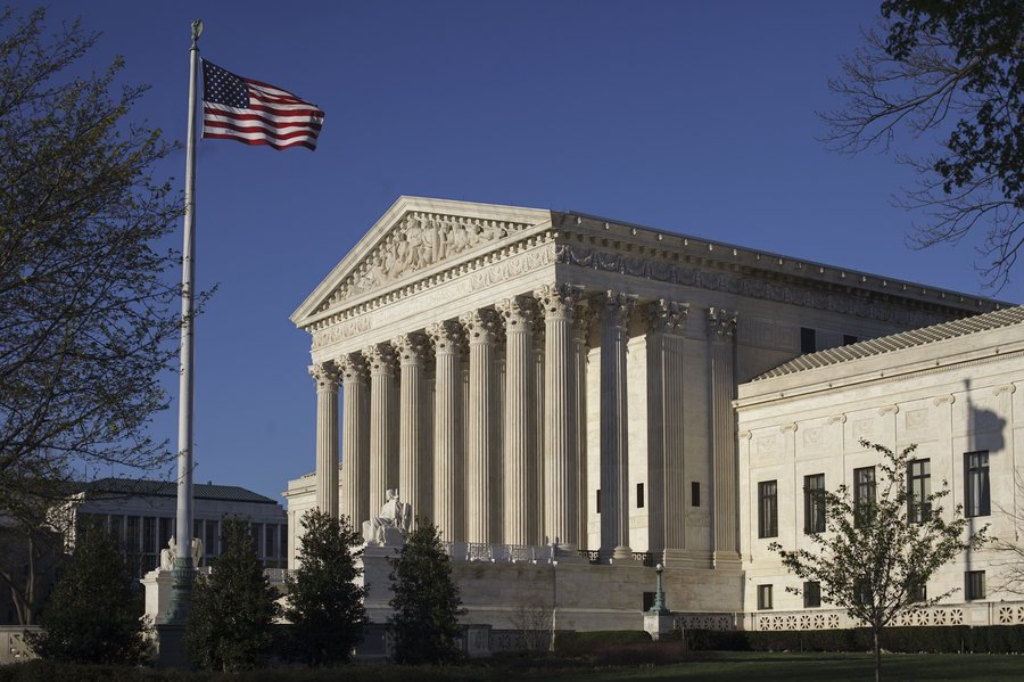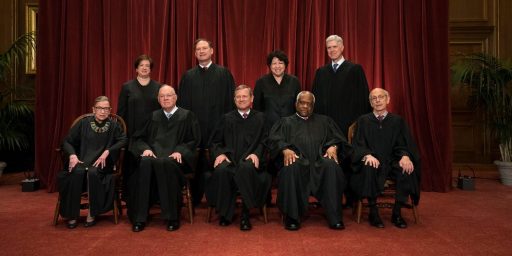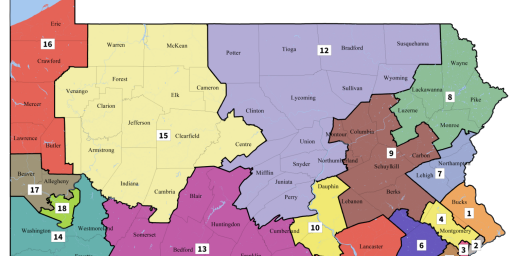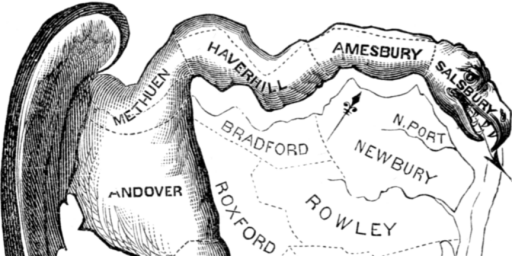Supreme Court Strikes Down Alabama Districts
A surprising ruling on the Voting Rights Act.

WaPo’s Robert Barnes(“Supreme Court: Alabama’s voting maps unfair to Black residents“):
A divided Supreme Court said Thursday that the Alabama legislature drew congressional districts that unlawfully diluted the political power of its Black residents, an unexpected decision from a court that recently has been more skeptical of the Voting Rights Act’s protections.
The 5-4 decision, written by Chief Justice John G. Roberts Jr., bucked the court’s recent trend of rulings that weakened provisions of the landmark 1965 act. He was joined by fellow conservative Justice Brett M. Kavanaugh and the court’s three liberals, Sonia Sotomayor, Elena Kagan and Ketanji Brown Jackson.
They upheld a decision by a three-judge panel that threw out Alabama’s maps for its seven congressional districts, which included only one with a majority of Black voters even though African Americans make up more than a quarter of the state’s population.
“We see no reason to disturb the District Court’s careful factual findings,” Roberts wrote, adding that Alabama was asking for a radical rewrite of the court’s precedents.
The decision likely means a second Democrat could be elected from the state — its delegation is now one Black Democrat and six White Republicans. And it will likely boost challenges of maps drawn by Republican-led legislatures elsewhere; federal judges in Georgia and Louisiana have found similar violations in maps from those states.
It was a surprise from a court whose conservative majority had signaled itwas suspicious of some sections of the Voting Rights Act, and was thought to be sympathetic to Alabama’s argument that the court’s precedents improperly required legislatures to prioritize race over traditional redistricting techniques.
Instead, Thursday’s opinion in effect preserves the status quo that has been in place for 40 years.
“The heart of these cases is not about the law as it exists,” Roberts wrote. “It is about Alabama’s attempt to remake our … jurisprudence.”
But the decision is notable from Roberts, who famously said in one of his early decisions in a redistricting case that “it is a sordid business, this divvying us up by race.” In Thursday’s case, he acknowledged concerns that abiding by the court’s guidance “may impermissibly elevate race in the allocation of political power within the States.”
“Our opinion today does not diminish or disregard these concerns,” he wrote. “It simply holds that a faithful application of our precedents and a fair reading of the record before us do not bear them out here.”
Alabama Attorney General Steve Marshall (R) said the ruling was disappointing but that the state will continue the litigation in a lower court.
“The Court made clear that its ruling was based only on the preliminary injunction record compiled in just a few weeks before the January 2022 district court ruling,” Marshall said in a statement. “The State is still entitled to put on our full case at trial, and we are confident that the evidence will make clear that voters in Alabama, regardless of their race, have the same opportunity as any other members of the electorate to participate in the State’s political processes and elect representatives of their choice.”
The ruling drew a sharp rebuke from Justice Clarence Thomas, who wrote that the question is whether the Voting Rights Act “requires the State of Alabama to intentionally redraw its longstanding congressional districts so that black voters can control a number of seats roughly proportional to the black share of the State’s population.”
The law, he said, “demands no such thing, and, if it did, the Constitution would not permit it.”
Thomas was joined in parts of his dissent by Justices Samuel A. Alito Jr., Neil M. Gorsuch and Amy Coney Barrett.
NPR’s Nina Totenberg (“Supreme Court unexpectedly upholds provision prohibiting racial gerrymandering“) adds:
At issue in the case was Alabama’s congressional redistricting plan, adopted after the 2020 census. The Republican-dominated legislature drew new district lines that packed large numbers of Black voters into one congressional district, and then spread out the remaining Black population in other districts so that black voters had little chance of electing a second representative of their choice in a racially polarized state.
A three judge district court that included two Trump appointed judges, found that the state legislature’s plan amounted to an illegal racial gerrymander under the voting rights act. And on Thursday, the Supreme Court agreed.
[…]
[UCLA law professor Richard]
Hasen said that the decision gives “minority voters have a fighting chance to get fair representation as Congress told them they would get in 1982, so it is preserving the status quo.”
University of Iowa Election law expert Derek Muller agrees, noting that a contrary ruling would have gutted the last remaining pillar of the landmark 1965 Voting Rights Act, undoing decades of settled law. The decision, he said, “also sort of speaks to Chief Justice Roberts approach, saying, ‘look, we’re not going to rock the boat. This is not something new.'”
But NYU’s Richard Pildes notes there is one thing new in the opinion, something that he says may, at first blush be missed. Pildes, who had cautiously predicted the outcome in the case, said Thursday’s decision “is more than just an affirmation of the status quo … because this whole case is based on new technological developments that make it easier for challengers” to find ways to create viable districts to protect their rights under the Voting Rights Act.
Indeed, it was the new technology of computer generated maps for redistricting based on traditional criteria like compactness, and keeping counties together that produced the redistricting map with a second majority black district in Alabama — a district that now will likely result in a second black member of congress from Alabama, and possibly a second Democrat to boot.
SCOTUSBlog’s Amy Howe (“Supreme Court upholds Section 2 of Voting Rights Act“) adds:
By a vote of 5-4 on Thursday, the justices issued a major voting rights decision, ruling that Alabama’s new congressional map likely violates the Voting Rights Act. But even more significantly, the court declined an invitation to adopt an interpretation of the act that would have made it much more difficult to challenge redistricting plans on the ground that they weaken the collective voting power of Black people.
The law at the center of the court’s decision in Allen v. Milligan is Section 2 of the Voting Rights Act, which bars election practices that result in a denial or abridgement of the right to vote based on race. Voters and other groups went to court in 2021 to challenge Alabama’s redistricting map for its seven seats in the U.S. House of Representatives. They argued that the map violated Section 2 by diluting the votes of the state’s Black residents, who make up 27% of the state’s population. Specifically, they said, the state’s new plan packed many Black voters into a single district in a part of central Alabama known as the “Black Belt,” while at the same time dispersing Black voters in the rest of the Black Belt into several other districts.
[…]
After nearly two hours of oral argument in October, a majority of the court appeared ready to side with the state and permanently set aside the lower court’s ruling. But with Kavanaugh joining forces with Chief Justice John Roberts and the court’s three liberal justices, the court on Thursday instead upheld the lower court’s ruling. In a 34-page opinion by Roberts, the majority agreed with the challengers that the lower court had correctly applied the Supreme Court’s 1986 decision in Thornburg v. Gingles, which outlines a three-part test to evaluate claims brought under Section 2, to reach its conclusion that the new map violated the VRA.
Roberts considered, but rejected, two of the state’s arguments regarding the Gingles framework. First, he gave little weight to the state’s contention that the maps that the challengers offered fell short because they failed to keep the Gulf Coast region, in the southwest part of the state, in the same district. “Only two witnesses testified that the Gulf Coast was” the kind of “community of interest” that should be preserved in the same district, Roberts observed. And in any event, he continued, the challengers’ maps “joined together a different community of interest called the Black Belt,” an area with a large number of rural Black voters, many of whom are the descendants of former enslaved persons.
Roberts next dismissed the state’s argument that the challengers’ maps, unlike the state’s maps, fail to retain the “core” of the previous maps. The Supreme Court, he stressed, “has never held that a State’s adherence to a previously used districting plan can defeat a” Section 2 claim. Otherwise, he said, states could “immunize from challenge a new racially discriminatory redistricting plan simply by claiming that it resembled an old racially discriminatory plan.”
The real issue before the court, Roberts explained, was not whether the lower court had applied existing law – Gingles – but instead “Alabama’s attempt to remake our §2 jurisprudence anew” by focusing on computer-generated maps that are created without considering race at all. But that single-minded focus on the computer-generated maps – the so-called “race-neutral benchmark” – is inconsistent with the VRA’s requirement that courts look at the entirety of the circumstances, Roberts observed. Moreover, he emphasized, such an interpretation would require a change to the Ginglesframework “that has been the baseline of our §2 jurisprudence for nearly forty years.”
Roberts also pushed back against the state’s suggestion that a race-neutral benchmark should be used because the Supreme Court’s current Section 2 case law “inevitably” requires states to ensure that the number of majority-minority districts is representative of the state’s demographics. Section 2 creates no such obligation, Roberts retorted, and the limitations imposed under the Gingles framework have in fact meant that, in recent years, Section 2 lawsuits have rarely been successful. The “exacting requirements” of Section 2, Roberts said, “limit judicial intervention to ‘those instances of intensive racial politics’ where the ‘excessive role [of race] in the electoral process … den[ies] minority voters equal opportunity to participate.”
Finally, Roberts rejected the state’s contention that the challengers should be required to show that any differences between the state’s plan and any race-neutral benchmarks can only be explained by racial discrimination. Both the court’s own cases and Congress “clearly” declined to require an intent to discriminate as a condition for liability under Section 2, he explained.
While I’ve paid a lot of attention over the last four decades to the court’s Constitutional interpretation of gerrymandering, this particular case centered on the interpretation of a statute. I don’t have a strong opinion on the matter but, given that two Trump appointees were in the majority in the lower court and Chief Justice Roberts and Justice Kavanaugh (also a Trump appointee) sided with the liberals to form a majority, I’m inclined to think they got it right.
As someone who moved to Alabama in late 1980, halfway through my freshman year in high school, and lived there off and on for the next 22 years, I’m surprised by the ruling. Not so much because the Roberts Court has been skeptical of the Voting Rights Act but because Alabama has had six “White” districts and one “Black” district for decades.
Indeed, when I started graduate school at the University of Alabama in 1992, I lived in the newly-drawn 7th Congressional District, which would elect Earl Hilliard, the state’s first Black Representative since Reconstruction, that fall. The district was one of the first of the “majority-minority” districts, part of a wave that had been strongly encouraged by the Justice Department, wherein state legislatures intentionally packed Black and/or Hispanic residents into a district to maximize their chances of election. Essentially, the 6th and 7th districts both included parts of Birmingham and Tuscaloosa, with the 6th having most of the more affluent parts of those cities and the 7th the least affluent parts. I was quite literally on the wrong side of the tracks, living across the street from the Section 8 housing and literally within walking distance of the 6th district.
Computer-aided districting was in its infancy in those days. But there was already a debate about the tradeoffs involved in racial gerrymandering. One could concentrate as many Black voters as possible in a single district—dubbed “packing”—and thus virtually assure White (and, increasingly, therefore Republican) Representatives in the other districts. Alternatively, one could divide the Black urban centers into multiple districts—dubbed “cracking”—and thus decrease the chances of a Black representative being elected but simultaneously increase the competitiveness of all the districts.
In the years that followed, numerous districts that were drawn pursuant to the 1990 Census were challenged in court, resulting in the three-pronged guidelines that Howe summarized. While extreme measures like North Carolina’s (which famously had a district that extended along an Interstate highway for such a long stretch that a wag quipped that, were the Representative to drive down the road with both his car doors open, he’d kill half his constituents) were struck down as violating the Equal Protection Clause, Alabama’s map survived.
I’ve paid much less attention to Alabama politics the last few cycles, having moved to Virginia almost 21 years ago now. But I’m not confident that the next map will result in two Black Representatives. There are lots of ways that the Supremes, and the Roberts Court itself, have ruled perfectly permissible to gerrymander to achieve partisan outcomes. They just need to be a little less ham-handed in using race as a proxy for Democratic Party.





Let’s not give Roberts too much credit here. He and his fellow Republicans put their very heavy thumb on the scales via the shadow docket and let Alabama use the unconstitutional gerry rig in the last election.
It should also be noted the ruling was basically, “since you didn’t challenge the law directly, we have to rule against you; feel free to come back later and challenge the law directly” and is not as much of a victory as some are portraying.
It might be a Ferengi maneuver.
Rule of Acquisition number Something: Every once in a while, declare peace. It confuses the hell out of your enemies.
Translation: If the injustice was accomplished long enough ago, it transcends from “injustice” to “tradition” and is thus venerated by Conservatives.